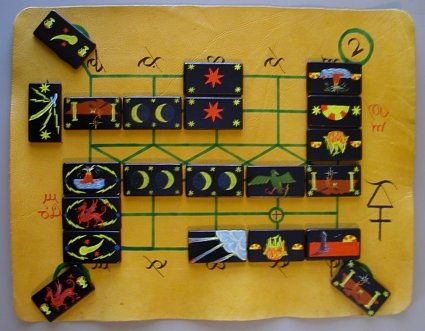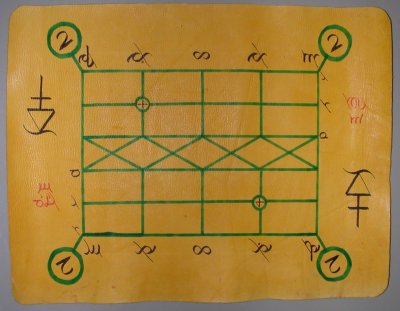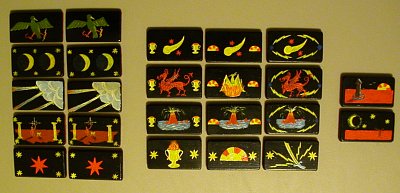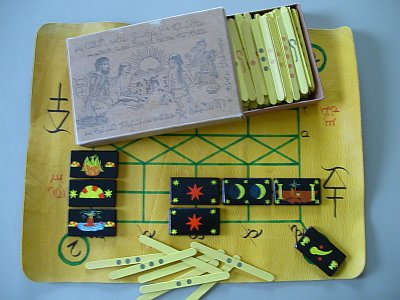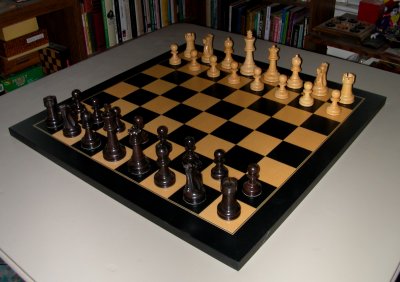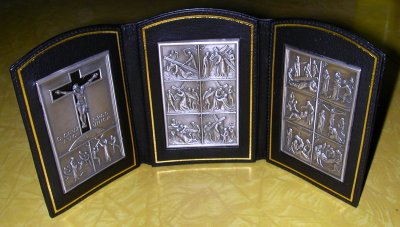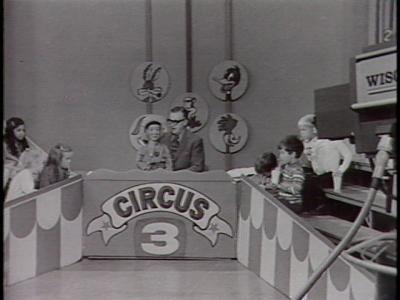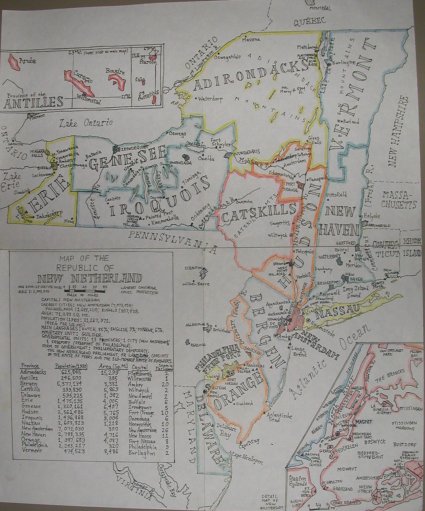 Fig. 1 Map of the Republic of New Netherland
Fig. 1 Map of the Republic of New NetherlandOnce upon a time in an alternate history, the Dutch did not lose their North American colony to the English. On today's East Coast, between New England and the rest of the United States, stands the Republic of New Netherland. Or, as its own citizens call it in Dutch,
de Republik van Nieuw-Nederland.
This is yet another fruit of my "radioactive core meltdown of the imagination." Actually I started working on New Netherland late, going into my mid 20s. I continued to work on it for ten years or more. Can't claim I've worked on it much since the early 1990s.
But talk about detail! I've got a list of every radio station in New Netherland, location, frequency, call letters, daytime and nighttime transmitter power. All the major highways, all the railroads. The 1980 census. The major league baseball teams of New Netherland's Knickerbocker League. A detailed history of the country. Reminiscences of the best (and worst) spots to smuggle goods in across the border from the United States. For New Netherland, you know, is a country unto itself.
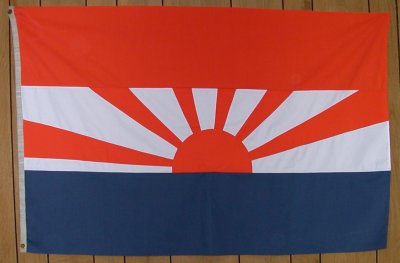 Fig. 2 Flag of the Republic of New Netherland
Fig. 2 Flag of the Republic of New NetherlandTo this day, hanging on the wall, I've got an actual full-sized flag of the Republic of New Netherland. Orange and white and blue, the old flag of the Prince of Orange, with a rising sun emblazoned on the middle stripe. I even composed the tune of New Netherland's national anthem,
Onze Patrie (
Our Fatherland): I've been known to astound friends by whistling it clear through from beginning to end.
The history of New Netherland begins, as in our timeline, with Henry Hudson exploring on behalf of the Netherlands, sailing up the Hudson River as far as the site of the present day Fort Orange [Albany]. The Dutch West India Company made a settlement in 1624, and in 1626 New Amsterdam was founded on Manhattan Island.
My alternate history diverges from our timeline in 1638, when
David Pietersen de Vries (and
not Willem Kieft) was appointed Director-General of New Netherland. As one history book puts it:
[In choosing] de Vries for the post... the States-General at a single stroke almost certainly prevented the Dutch colony in North America from eventually slipping out of their grasp...
De Vries had been a merchant skipper before coming to New Netherland. He was by all accounts a remarkable personality: shrewd, clear-headed, conciliatory but firm. De Vries was humane but unyielding in pressing forward to his goals... De Vries' first measure was to press for ending the fur trade monopoly of the Dutch West India Company. At the same time, he launched an intensive and successful campaign in Europe to draw a greater number of settlers to New Netherland. De Vries saw that the Dutch colony in the New World, if it was to survive, must become a true colony, and not just a station for a trading company.
De Vries established good relations with the Five Nations of the Iroquois. He fostered a degree of self-government in the colony with the setting up of the College of Twelve, which was the forerunner of today's New Netherlander Parliament. He pressed for the Connecticut River [
Varsche Kill] as the boundary between New Netherland and the English colonies in New England, and he annexed the Swedish colony of New Sweden, along the Delaware River [South River,
Zuid Kill] as the Dutch colony of New Amstel.
Most importantly, when the English sent four frigates in 1664 to take the chief colonial city of New Amsterdam:
They found a well-fortified city of eight thousand souls; de Vries had ordered the city prepared for the defense. In the ensuing battle, Dutch cannon sunk two of the English frigates, and the remaining two fled amidst fearsome volleys from the shore. The English attempt to seize the Dutch colonies in America had failed.
The English were eventually to recognize the Dutch title to New Netherland. De Vries was succeeded on his death by Hendrik Watervliet as Director-General. It was Watervliet who concluded an accord with his personal friend, William Penn, to establish the city of Philadelphia as a city under Dutch sovereignty with free trade rights to and from Pennsylvania through Philadelphia. Watervliet also oversaw the organization of the two provinces of Hudson and the Catskills in the valley of the Hudson River [North River,
Noort Kill], where Dutch
patroons with their land-grant feudal manors had been vying with one another for influence and power.
The Dutch remained neutral during the American Revolution. But New Netherland found itself on the path to independence when Napoleon Bonaparte seized the Netherlands in 1795. Director-General
Philip Schuyler assumed administrative control of the Dutch colonies in the New World. A convention was gathered in New Amsterdam, and in 1798 the Constitution of the independent Republic of New Netherland was proclaimed.
Schuyler became the first Prime Minister of New Netherland, though he soon stepped down due to ill health. He was succeeded as Prime Minister by the patroon
Stephen van Rensselaer. The first party divisions emerged, between the Conservatives ("Long Pipes") and Liberals ("Short Pipes").
The great New Netherlander statesman of the 19th century was
Maarten van Buren, who became Prime Minister in 1820, and held the post for most of the next 36 years. This was the era when the
Erie Canal was constructed, which for a time made New Netherland a major power in commercial transport to and from the interior of North America. This was also the era of the
Anti-Rent War (1841-46), which ended in the patroons being stripped of their feudal manorial powers and reduced to a mere titled nobility.
Anti-slavery sentiment fueled New Netherlander aid to the Union in the Civil War, especially after
Schuyler Colfax became Prime Minister (1863-77).
Theodore Roosevelt served as Prime Minister for most of the period 1897-1919, and New Netherland entered World War I in 1917 on the side of the Allies.
With the stock market crash in 1929, the Conservative government of Vermonter Calvin Coolidge resigned by the spring of 1930, and Franklin Delano Roosevelt headed up a Liberal government until his death in 1945. This was the period of the Great Depression and World War II, which New Netherland entered in 1940. FDR is also remembered for the constitutional crisis of 1935, when he extended the term of his government, and postponed national elections, one year beyond the constitutionally mandated five-year limit.
In 1948
Quentin Roosevelt, son of TR, became Prime Minister and led a Conservative government which continued until his death in 1965. It was the 1960s: three governments fell in the next 18 months, followed by the government of the first Iroquois Prime Minister of New Netherland, Oren Lyons (1967-74), under whom New Netherland broke with the US and by 1968 withdrew its forces from Vietnam. The tempestuous Lyons era was brought to an end in late 1974, when the President of New Netherland, a purely ceremonial appointive post, forced a constitutional crisis by asserting authority to unilaterally dissolve Parliament and call for elections.
Liberal Prime Minister D. Patrick Moynihan found his own party split between moderates and radicals, and he was forced to form a coalition "Neo-Conservative" government of Conservatives and moderate Liberals. In 1983 Jack Kemp became Conservative Prime Minister. The current Prime Minister of New Netherland is Rudy Giuliani.
The Government: The Parliament [
Landdag] of New Netherland is comprised of two houses, the lower House of Burghers and the upper House of Peers. In practice, virtually all legislative power is vested in the House of Burghers. This lower house consists of 120 burghers, popularly elected, and apportioned among the provinces proportional to their populations as determined in a decennial census. The House of Peers consists of 40 patroons, five Iroquois chiefs, about 50 hereditary peers, about 150 life peers, one steward of the freeport, seven chancellors, and such other members as the House of Peers may itself admit (such as the President of New Netherland, the ambassador to the League of Nations, etc.).
The Prime Minister may choose his cabinet either from within or from without the Parliament, including such cabinet posts as the Koopman (secretary and parliamentarian of the cabinet), the
Schout-Legal, the Schout-Fiscal, etc.
Political Parties: The two largest parties in New Netherland are the Conservative Party and the Liberal Party. Other parties which usually capture at least a few seats in Parliament are the Labor Party, the Socialist Party, and the right-wing Independent Progressive Party. The Communist Party reliably polls a number of votes, but has not held any seats in Parliament since the 1930s.
The Provinces: New Netherland is divided into 13 provinces, one city (New Amsterdam), and one freeport (Philadelphia).
The Law: New Netherland derives its legal heritage from Dutch law, based on Roman law, with some influences and admixtures from the English common law adopted by osmosis from the surrounding United States. The highest appellate court in most cases is the Chancellory, whose seven chancellors are nonvoting members of the House of Peers. The powers of the Chancellory do not extend to judicial review of legislation, and in some legal matters (the Maritime courts, the Freeport, Iroquois affairs) there are other courts which function as court of highest appeal.
Languages: According to the 1980 census, Dutch was the first language of about 85% of the population of New Netherland; English, of about 9%; Iroquois languages (Mohawk, Oneida, Onondaga, Cayuga, and Seneca), about 6%; and French, about 0.1%. This does not include the complicated linguistic situation of the Antilles, with Papiamento, Spanish, Portuguese, etc.
Areas which are majority English-speaking include the cities of Philadelphia, New Haven, and Hartford, and also eastern Vermont and the east end of Long Island. Iroquois languages are spoken in the Iroquois province and also among the several hundred thousand Mohawks in New Amsterdam. There are important English-speaking minorities in New Amsterdam and in Buffalo, and a sprinkling of English speakers in many other cities of New Netherland.
The spoken Dutch in New Netherland has diverged somewhat from the Dutch of the Netherlands, but the two are still more or less mutually intelligible. Up through World War I, European Dutch was employed in New Netherland as the literary language. But today the literary language in New Netherland is based much more closely on the spoken language.
Radio: Far out into the American heartland, radio stations from New Netherland can be received at night: D2CO 880 New Amsterdam, D2CA 1210 Philadelphia, D2R 710 New Amsterdam, D2Y 810 Schaeneckstede, D2WH 1180 Irondequoit; to say nothing of the several shortwave stations from New Netherland; and also two longwave stations, D2YZ 216 New Amsterdam and D2G 252 Buffalo, which date back to FDR's public works projects in the 1930s.
The national radio network in New Netherland is NNRK [
Nieuw-Nederlander Radiotelephonische Koorpershaft], and in the 1950s the government organized a second "cultural" radio network; but there are also many private and commercial radio stations. The national television network is the Orange Network, which for many years was presided over by the benign authoritarian figure of Colonel Cornelius ten Broek, World War II hero of the old New Netherland Signal Corps.
Military: New Netherland has an Army, a Navy, an Air Force, and also the Iroquois Native Guard (who make the US Marines look like pantywaists).
Intelligence: The intelligence agency of New Netherland is Bluelight [
Blauwlicht]. Not to be compared to the FBI, CIA, or NSA. More like the Mossad. Quick, efficient, direct, and sometimes not too heedful of niceties.
Baseball: In the world of New Netherland, all major league baseball teams are located no further west than the Mississippi, and not much further south than the Mason-Dixon line. In addition to the US and its National League and American League, New Netherland has eight major league baseball teams in the Knickerbocker League: the New Amsterdam Knickerbockers, the Breuckelen Dodgers, the Bergen Nine, the Philadelphia Phillies, the Buffalo Bisons, the Irondequoit Skylarks, the Onondaga Iroquois, and the Hartford Yellow Sox.
Gasoline: Everywhere you go in New Netherland, it's
Blue & White gas.
Blauw en Wit— de gasolijn, die Nieuw-Nederland gaan laat! ("Blue & White— the gasoline that makes New Netherland go!") And probably that gas goes into your Selden economy sedan, Van Buren luxury car, or Herkul truck, all manufactured by the Selden Automotive Corporation in Irondequoit, Genesee.
United States: Still has 50 states, with the addition of
Plymouth,
Franklin,
Lincoln, and Puerto Rico. American culture in the world of New Netherland has been centered much more in mid-sized cities such as Boston, Baltimore, etc. American Presidents in this alternate history include
Henry Clay (1837-1845),
Lewis Cass (1849-1857),
Samuel Tilden (1877-1881),
Philander Knox (1901-1909),
Charles Hughes (1923-1929), and the Progressive
Robert M. La Follette, Jr. (1933-1953).
And that's only scratching the surface. I have tons and tons of material on the Republic of New Netherland, up through the early 1990s. All set in a world where the Dutch never lost their North American settlements to the English...
Name: The Republic of New Netherland (Dutch:
de Republik van Nieuw-Nederland).
Area: 71,288 square miles.
Population: (1980 census) 31,267,971.
Capital: New Amsterdam (
Nieuw-Amsterdam).
Largest Cities: New Amsterdam (7,071,030); Philadelphia (1,688,210); Buffalo (357,870).
Languages: Dutch, 84.8%; English, 8.8%; Iroquois (Cayuga, Mohawk, Oneida, Onondaga, Seneca), 6.3%; French, 0.1%. Also a scattering of Spanish, Papiamento, and Portuguese in the Antilles.
Head of State: Eduard van Rensselaer, Patroon van Rensselaerwyck, President of New Netherland.
Head of Government: Rudy Giuliani, Prime Minister of New Netherland (Conservative).
Legislature: Parliament (
Landdag): lower House of Burghers, 120 elected members; upper House of Peers, made up of appointed and hereditary members.
Currency: Guilder (fl.); fl.1 = US 27¢. 1 Guilder = 20 Stivers = 100 Cents.
Administrative Units: 13 provinces, 1 city, 1 freeport. All populations are 1980 census:
- Adirondacks (Adirondacken), pop. 625,845; area, 15,299 sq. mi.; cap., Plattsburgh; seats in parliament, 2.
- Antilles (Antillen), pop. 246,500; area, 385 sq. mi.; cap., Willemstad; seats in parliament, 1.
- Bergen, pop. 5,377,134; area, 3,381 sq. mi.; cap., Amboy; seats in parliament, 20.
- Catskills (Kaatskillen), pop. 399,890; area, 5,869 sq. mi.; cap., Wiltwyck; seats in parliament, 2.
- Delaware (Zwaanendael), pop. 595,225; area, 1,982 sq. mi.; cap., New Amstel (Nieuw-Amstel); seats in parliament, 2.
- Erie, pop. 1,475,195; area, 4,005 sq. mi.; cap., Buffalo; seats in parliament, 6.
- Genesee, pop. 1,320,161; area, 6,407 sq. mi.; cap., Irondequoit; seats in parliament, 5.
- Hudson, pop. 2,562,486; area, 5,765 sq. mi.; cap., Fort Orange (Fort-Oranje); seats in parliament, 10.
- Iroquois, pop. 1,496,868; area, 9,004 sq. mi.; cap., Onondaga; seats in parliament, 6.
- Nassau (Nassouwen), pop. 2,603,813; area, 1,218 sq. mi.; cap., Heemstede; seats in parliament, 10.
- New Amsterdam, City of (Stad van Nieuw-Amsterdam), pop. 7,071,030; area, 300 sq. mi.; cap., New Amsterdam; seats in parliament, 26.
- New Haven (Nieuw-Haven), pop. 2,788,395; area, 4,716 sq. mi.; cap., New Haven (Nieuw-Haven); seats in parliament, 11.
- Orange (Oranje), pop. 1,987,689; area, 4,087 sq. mi.; cap., Fort Nassau (Fort-Nassouwen); seats in parliament, 8.
- Philadelphia, Freeport of (Vrijport van Philadelphie), pop. 2,243,217; area, 320 sq. mi.; cap., Philadelphia; seats in parliament, 9.
- Vermont, pop. 474,523; area, 8,486 sq. mi.; cap., Burlington; seats in parliament, 2.
Labels: worlds








